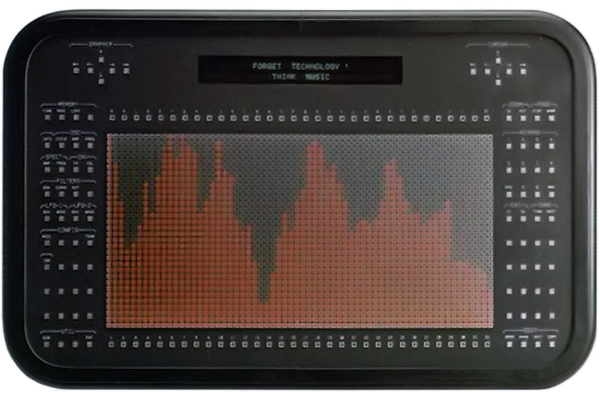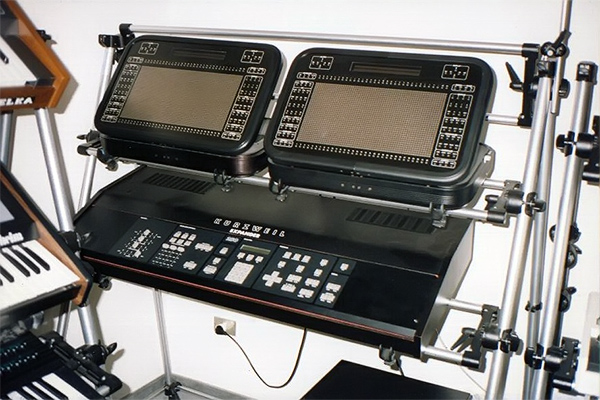 Technos Acxel came out in 1987 in Quebec and draw immediate attention to its unique concept. Pierre Guilmette’s engineering and Nil Parent’s design were truly amasing and revolutionary and we talking about the 1980s. The word “Acxel” defines “acoustic element” (a pixel is an image element, so “acxel” is kind of a “pixel” derivative). The instrument got its name according to its concept: each sound can be generated from a finite number of separate waves.
Technos Acxel came out in 1987 in Quebec and draw immediate attention to its unique concept. Pierre Guilmette’s engineering and Nil Parent’s design were truly amasing and revolutionary and we talking about the 1980s. The word “Acxel” defines “acoustic element” (a pixel is an image element, so “acxel” is kind of a “pixel” derivative). The instrument got its name according to its concept: each sound can be generated from a finite number of separate waves.
Technos Acxel – how it works
Acxel uses the principles of resynthesis as well as digital additive sound modeling with the help of sine wave generators each of which has its own envelope for frequency and amplitude to form the harmonic content of the sound.
Technos Acxel operation is a bit similar to sampling and was actually meant to be an alternative though making a significant difference in the way it works: it doesn’t convert the signal. While samplers comprise an A/D converter to convert a continuously-variable analogue signal into digital data, Pierre Guilmette’s sound resynthesis and the very work of Technos Acxel is about breaking harmonic content of a sound down into a finite number of variable-amplitude and variable-frequency sine waves (utilising a FFT - Fast Fourier Transform - analysis) so that you can completely change the sound altering each wave individually. Acxelizer is the system component responsible for that stage of the processing and the total number of sine waves can be up to 1024. That’s how the fundamental sound change happens and that’s what resynthesis (fr. ré-synthèse) means.
Moreover besides the processing of already existing sound Acxel gives an opportunity to produce it from scratch. The device does it with the help of those waveform generators which can create sine waves allowing for their further transformation at a go into other wave shapes. The instrument included a wide palette of parameters and control elements which let you not only create sounds from scratch but also edit them in real time. The actual work with sound is entertaining enough: you “draw” on the matrix LED display. So you actually “draw” waveforms and envelopes (to such oscillator parameters as amplitude and frequency). To process the waveform there are also a digital multifilter (LPF/ HPF/ BPR/user) called Color. FM is here for you as well to assist the envelopes.
Despite the fact that Technos Acxel was developed in the 1980s it features MIDI (even programmable curves control). There’s more to its functionality: timbres layering, sound segment length change, chorus.
And how does it look?
 The resynthesizer includes two separate components: “Grapher” (graphic console) and “Solitary” (synthesis and analysis hardware in a rackmount). Instead of an LCD Acxel offers a special fluorescent display – there are 2114 touch sensitive LED sensors on its surface.
The resynthesizer includes two separate components: “Grapher” (graphic console) and “Solitary” (synthesis and analysis hardware in a rackmount). Instead of an LCD Acxel offers a special fluorescent display – there are 2114 touch sensitive LED sensors on its surface.
And what about Acxel II?
Did Pierre Guilmette and Nil Parent plan any elaboration? Acxel II project was started up 20 years after and was patronized by Idarca-Audio company. Pierre Guilmette was going to introduce lots of new functions including some extra sound editing possibilities as well as an increased efficiency. But inspite of the promising start Acxel II was never released – Idarca-Audio company went broke and couldn’t recover.
We should also note that Acxel wasn’t consigned to oblivion - Pierre Guilmette and Nil Parent made a creature which now lives in modern resynthesizers (VirSyn Cube, Camel Audio Cameleon 5000 (Ben Gillett’s design), Image-Line Harmor). Anyway if you need that cosmic sound you can resort to Hartmann Neuron as well.
